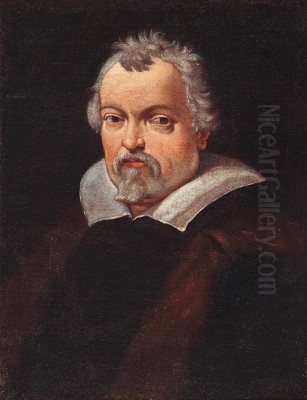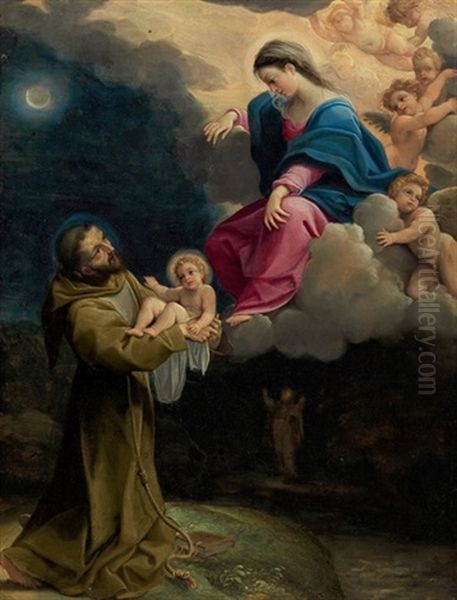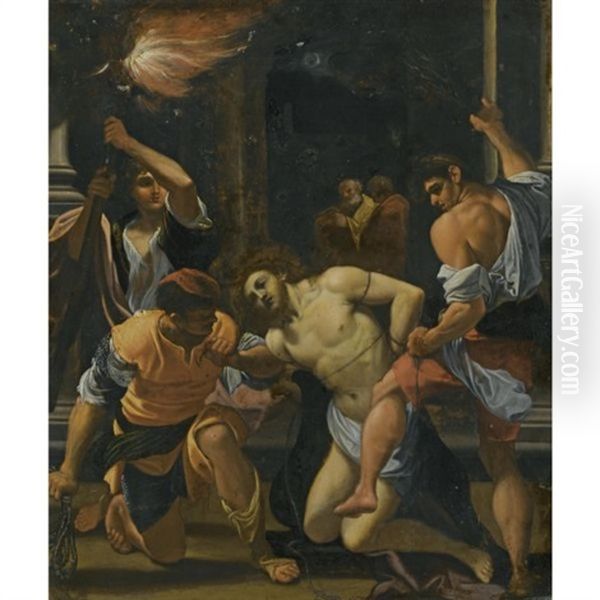Introduction: A Bridge Between Eras

Ludovico Carracci stands as a pivotal figure in Italian art history, an artist whose life and work bridged the late Renaissance Mannerist style with the burgeoning energy of the Early Baroque. Born in Bologna on April 21, 1555, and passing away in the same city on November 13, 1619, Ludovico was a painter, printmaker, and etcher of considerable influence. He is perhaps most famously remembered as one of the founders, alongside his talented cousins Annibale and Agostino Carracci, of the groundbreaking Accademia degli Incamminati. This institution played a crucial role in steering Italian art away from the artificiality of late Mannerism towards a renewed focus on naturalism, emotional depth, and classical clarity, effectively laying the groundwork for the Baroque style in Bologna and beyond.
Early Life and Artistic Formation
Ludovico Carracci emerged from a modest background in Bologna, his family connected to the butcher's trade. This grounded upbringing perhaps subtly influenced his later emphasis on observing the realities of life. His formal artistic training began in Bologna under the tutelage of Prospero Fontana, a prominent representative of the local Mannerist school. Fontana's studio provided Ludovico with foundational skills, but the young artist soon sought broader horizons and deeper inspiration.
His quest for knowledge led him on travels to major artistic centers in Italy. He spent time in Florence, absorbing the lessons of High Renaissance masters and the principles of Florentine disegno (design and drawing). He journeyed to Parma, where the works of Antonio da Correggio made a profound impact. Correggio's mastery of soft light, graceful movement, and tender emotion would resonate in Ludovico's own art. Venice offered exposure to the rich colorito and dramatic compositions of Titian and Tintoretto. While initially apprenticing briefly with Tintoretto, Ludovico reportedly found the master's dynamic style perhaps too overwhelming or not entirely suited to his temperament, ultimately gravitating more towards the balanced classicism of Titian and the emotive grace of Correggio. These diverse influences coalesced to shape his unique artistic voice.
The Carracci Academy: A Revolutionary Approach

A defining achievement of Ludovico's career was the establishment of an academy, a collaborative venture with his cousins Agostino and Annibale. Founded around 1582, it was initially called the Accademia dei Desiderosi ("Academy of the Desirous," implying a desire for fame and learning). It was later renamed the Accademia degli Incamminati ("Academy of Those Opening the Way" or "Progressives"). This change reflected their ambitious goal: to reform art education and practice.
The Carracci Academy represented a significant departure from the traditional workshop apprenticeship system and the perceived stagnation of late Mannerism. Its core principles centered on a return to nature and the study of High Renaissance masters. The curriculum emphasized direct observation, life drawing using models, and the study of human anatomy to achieve realistic depictions. However, this naturalism was tempered by an appreciation for the ideal beauty found in classical sculpture and the works of artists like Raphael and Michelangelo. They sought a synthesis, combining Lombard naturalism, Venetian color, and Florentine-Roman design.
While Annibale was arguably the most naturally gifted painter and Agostino a master engraver and theorist, Ludovico served as the guiding spirit and principal leader of the academy, especially after his cousins departed for Rome around 1595. He remained in Bologna, steering the institution for many years. The academy aimed to cultivate well-rounded artists, knowledgeable not only in painting and drawing but also in perspective, architecture, and even literature and philosophy.
Artistic Style and Techniques
Ludovico Carracci's style is characterized by its synthesis of influences and its distinct emotional tenor. He successfully blended the elegance inherited from late Renaissance traditions with the dynamism and naturalism that would define the Baroque. His early work shows the clear impact of Correggio's sfumato and graceful figures, as well as the rich color palette of the Venetians, particularly Titian.
A hallmark of his style is a profound sense of piety and emotional sincerity, especially in his religious works. He moved away from Mannerist artificiality, striving for genuine human feeling and psychological depth. His figures often convey pathos and devotion through expressive gestures and facial features. This focus on emotional resonance aligned well with the Counter-Reformation's call for art that could inspire faith and piety in the viewer.

Ludovico masterfully employed chiaroscuro – the dramatic interplay of light and shadow – to heighten the emotional impact and create a sense of volume and space. While perhaps not as starkly contrasted as his contemporary Caravaggio's tenebrism, Ludovico's use of light is often warm and atmospheric, bathing scenes in a palpable mood. His compositions are typically well-structured, often built on stable diagonal or pyramidal arrangements, lending dignity and clarity to the narrative. He possessed a strong sense of design, ensuring that even complex multi-figure scenes remained coherent and focused. Beyond painting, Ludovico was also a skilled printmaker, producing etchings that demonstrated his fine draftsmanship.
Key Works and Masterpieces
Ludovico Carracci's oeuvre consists primarily of religious paintings, including numerous altarpieces and devotional works for churches and patrons in Bologna and the surrounding region. Several works stand out as representative of his style and contribution:
The Annunciation (c. 1583-84, Pinacoteca Nazionale, Bologna): An early masterpiece, this work clearly shows the influence of Correggio in the soft modeling of the figures and the gentle, divine light illuminating the scene. It exemplifies the Carracci's move towards a more naturalistic and emotionally accessible depiction of sacred events compared to late Mannerist conventions.
The Holy Family with St. Francis and Donors (1591, Pinacoteca Civica, Cento): This painting showcases Ludovico's ability to combine intimate devotional feeling with formal portraiture. The figures interact with tender naturalism, bathed in a warm light, demonstrating his mature style that balances realism with grace.
The Lamentation over the Dead Christ (c. 1585, Metropolitan Museum of Art, New York - though other versions exist): This subject allowed Ludovico to explore profound grief and pathos. His depictions typically focus on the raw emotion of the Virgin Mary and other mourners, rendered with realistic weight and anatomical correctness, yet imbued with spiritual intensity through the use of dramatic lighting.
The Dream of Saint Catherine of Alexandria (c. 1593, National Gallery of Art, Washington D.C.): This work captures a mystical vision with delicate brushwork and a dreamlike atmosphere. It highlights Ludovico's skill in portraying the inner spiritual experiences of saints, blending the earthly and the divine.
The Preaching of St. John the Baptist (c. 1611, San Michele in Bosco, Bologna): A later work, this painting demonstrates Ludovico's continued commitment to clear narrative and strong composition. The figures are robust and expressive, arranged dynamically within the landscape setting.
The Last Communion of Saint Jerome (c. 1611, San Michele in Bosco, Bologna): Often compared to the version by his cousin Agostino and later Domenichino, Ludovico's treatment of this theme emphasizes the solemnity and piety of the moment, using controlled light and composition to focus the viewer's attention on the sacrament.

The Martyrdom of Saint Margaret (c. 1600, San Maurizio, Mantua): This painting exemplifies Ludovico's ability to handle dramatic and violent subject matter with emotional force. The use of strong diagonals, dynamic poses, and focused lighting creates a powerful image of faith confronting brutality.
These works, among many others housed in churches and museums primarily in Bologna but also internationally, solidify Ludovico's reputation as a master of religious narrative and emotional expression.
Contemporaries and Collaborations
Ludovico's career unfolded during a vibrant period in Italian art. His most significant collaborators were, of course, his cousins Agostino Carracci (1557-1602) and Annibale Carracci (1560-1609). Together, they undertook important decorative projects in Bologna, such as the frescoes in the Palazzo Fava (c. 1583-84) and Palazzo Magnani (c. 1590-92), before Annibale and Agostino achieved fame in Rome. Their shared commitment to artistic reform was foundational, though their individual styles diverged over time, with Annibale leaning more towards classicism and Ludovico retaining a stronger emotional, sometimes more somber, intensity.
In Bologna, Ludovico interacted with other established artists. His teacher, Prospero Fontana (1512-1597), represented the older Mannerist generation they reacted against. Another significant Bolognese contemporary was Bartolomeo Passerotti (1529-1592), known for his genre scenes and portraits, whose robust naturalism may have offered another local point of reference.
The towering figure of Caravaggio (Michelangelo Merisi da Caravaggio, 1571-1610) emerged as a powerful, contrasting force in Rome during the period the Carracci were active there. While Ludovico remained primarily in Bologna, the dramatic naturalism and intense chiaroscuro of Caravaggio represented an alternative path within the Baroque, often seen as more raw and revolutionary compared to the Carracci's more classically grounded reform.
The Accademia degli Incamminati, under Ludovico's guidance, became a crucible for the next generation of Bolognese masters. Among his most celebrated pupils were Guido Reni (1575-1642), known for his elegant classicism and refined religious and mythological scenes; Domenichino (Domenico Zampieri, 1581-1641), praised for his compositional clarity and expressive narratives; Francesco Albani (1578-1660), famed for his charming mythological landscapes; and Giovanni Lanfranco (1582-1647), who developed a more dynamic, High Baroque style, particularly in ceiling frescoes. Other notable artists associated with Ludovico and the academy include Alessandro Tiarini (1577-1668), Lionello Spada (1576-1622, who later showed Caravaggesque influence), and Giacomo Cavedone (1577-1660). These artists, shaped by the Carracci reform, established the dominance of the Bolognese School in the early 17th century.
Controversies and Challenges
While the Carracci Academy was highly influential, it was not without its complexities and criticisms. Art historians have debated the precise nature of the institution – whether it was a formally structured academy with a set curriculum or a more informal workshop centered around the Carracci cousins. The evidence suggests it likely combined elements of both, evolving over time.
The Carracci's emphasis on drawing from life and studying anatomy was revolutionary but also drew some criticism. Some later commentators felt their approach, while rejecting Mannerist artifice, could sometimes lead to a different kind of academicism, potentially stifling individual creativity or romantic impulse in favor of established formulas and idealized naturalism. This critique became more pronounced in later centuries with the rise of Romanticism.
Furthermore, the academy faced practical challenges. After the departure of Annibale and Agostino for Rome, the full burden of leadership fell on Ludovico. Maintaining the institution required resources, and like many artistic ventures, it likely faced periods of financial strain. Sources suggest the academy experienced a decline in its later years, possibly due to funding issues or changing artistic currents, reportedly dissolving around 1613, although its influence continued through its former students.
Later Life and Legacy
While Annibale and Agostino sought greater fame and fortune in Rome, working for powerful patrons like the Farnese family, Ludovico chose to remain in his native Bologna. He became the undisputed head of the Bolognese school after his cousins' departure and eventual deaths. He continued to receive prestigious commissions for altarpieces and frescoes in the city and surrounding region, remaining artistically active until his death in 1619.
Ludovico Carracci's legacy is substantial and multifaceted. He played an indispensable role in the transition from Mannerism to Baroque. His commitment to naturalism, emotional depth, and clear composition provided a vital counterpoint to the prevailing artistic trends of his youth. The "Carracci Reform," as it came to be known, revitalized painting in Bologna, transforming the city into a major artistic center whose influence radiated throughout Italy and Europe.
His most enduring legacy is perhaps the Accademia degli Incamminati. Through this institution, he and his cousins trained a generation of artists who would dominate Italian painting in the first half of the 17th century. The principles taught at the academy – emphasizing drawing, observation from life, study of the masters, and a balance between naturalism and classicism – became foundational for academic art education for centuries, influencing institutions like the French Royal Academy of Painting and Sculpture. While Annibale is often credited with the greater artistic genius, Ludovico's steadfast leadership in Bologna and his deeply felt artistic vision ensured the long-term impact of their shared project.
Conclusion: An Enduring Influence
Ludovico Carracci occupies a crucial position in the narrative of Italian art. He was more than just a talented painter; he was a reformer, an educator, and a guiding force. Alongside his cousins, he challenged the artistic status quo, advocating for a return to observation and sincere emotion, tempered by classical ideals. His own works, particularly his religious paintings, resonate with a quiet intensity and profound piety that distinguishes them. By remaining in Bologna and nurturing the Accademia degli Incamminati, he ensured the continuation and dissemination of the Carracci's artistic principles, shaping the course of the Baroque era and leaving an indelible mark on the history of European art. His contributions as both an artist and a teacher solidify his status as a key figure of the Early Baroque.